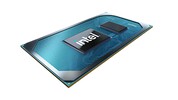Intel Core i3-380UM vs Intel Core i5-1155G7
Intel Core i3-380UM
► remove from comparisonThe Intel Core i3-380UM is a Ultra Low Voltage dual-core processor for small and light laptops. It is clocked with 1.3 GHz and does not feature Turbo Boost to overclock the CPU cores. Another feature missing compared to the i5 and i7 lineup is the AES function block. Each core is based on the Nehalem (Westmere) micro-architecture. Hyperthreading enables the Dual Core CPU to handle 4 threads at once (for a better usage of the pipeline).
The similar Core i5-470UM, i5-560UM, and i7-660UM are also clocked at a base speed of 1.3 GHz, but feature Turbo Boost and are therefore faster.
A feature of the new Core i3-380UM is the integrated graphics card (called Intel HD Graphics) and memory controller. Both are on a separate die that is still manufactured in 45nm whereas the CPU die is already manufactured in the new 32nm process. The also called GMA HD is able to use Turbo Boost to overclock from 133 to 500 MHz.
Due to the integrated memory controller and HyperThreading, the Core i3-380UM is faster than a similar clocked Core 2 Duo (1.3 GHz) in all (us known) applications and benchmarks. Therefore it beats the 1.3 GHz Pentium SU7300 and performs in some areas even as fast as a 2 GHz Core 2 Duo. Still the gaming performance can suffer from the low clock speed.
The power consumption of 18 Watt TDP (max.) counts for the whole package and therefore it is clearly better than the 17 Watt TDP of the Core 2 Duo SL-series (CPU alone).
Intel Core i5-1155G7
► remove from comparison
The Intel Core i5-1155G7 is a power efficient quad-core SoC for laptops and Ultrabooks based on the Tiger Lake-U generation that was announced in mid 2021 as part of the refresh. It integrates four Willow Cove processor cores (8 threads thanks to HyperThreading). The base clock speed depends on the TDP settings and ranges from 1 GHz (12 Watt TDP) up to 2.5 GHz (28 Watt). Boost clock speed is 4.5 GHz.
Tiger Lake SoCs add PCIe 4 support (4 lanes), AI hardware acceleration, and the partial integration of Thunderbolt 4 / USB 4 and Wifi 6 in the chip.
Another novelty is the integrated Xe graphics adapter with 80 EUs based on the completely new Gen 12 architecture. It offers a significantly higher performance compared to the older Iris Plus G7 (Ice Lake).
Performance
The average 1155G7 in our database proves to be a very decent mid-range processor, as of mid 2022, trading blows with the Core i7-10810U and the Ryzen 5 4500U as far as multi-thread benchmark scores are concerned. While perhaps not the best option for power users, this Core i5 will make most consumers happy, providing for short load times and generally pain-free experience.
Your mileage may vary depending on how high the CPU power limits are and how competent the cooling solution of your system is.
Power consumption
This Core i5 series chip has a default TDP, also known as the long-term power limit, of 12 W to 28 W, the expectation being that laptop makers will go for a higher value in exchange for higher performance. Either way, this is a tad too high to allow for passively cooled designs.
The i5-1155G7 is built with Intel's third-gen 10 nm process marketed as SuperFin for lower-than-average, as of early 2023, energy efficiency.
| Model | Intel Core i3-380UM | Intel Core i5-1155G7 | ||||||||||||||||||||||||||||||||||||||||||||||||||||||||||||
| Codename | Arrandale | Tiger Lake-UP3 | ||||||||||||||||||||||||||||||||||||||||||||||||||||||||||||
| Series | Intel Core i3 | Intel Tiger Lake | ||||||||||||||||||||||||||||||||||||||||||||||||||||||||||||
| Series: Tiger Lake Tiger Lake-UP3 |
|
| ||||||||||||||||||||||||||||||||||||||||||||||||||||||||||||
| Clock | 1333 MHz | 2500 - 4500 MHz | ||||||||||||||||||||||||||||||||||||||||||||||||||||||||||||
| FSB | 2500 | |||||||||||||||||||||||||||||||||||||||||||||||||||||||||||||
| L2 Cache | 512 KB | 5 MB | ||||||||||||||||||||||||||||||||||||||||||||||||||||||||||||
| L3 Cache | 3 MB | 8 MB | ||||||||||||||||||||||||||||||||||||||||||||||||||||||||||||
| Cores / Threads | 2 / 4 | 4 / 8 | ||||||||||||||||||||||||||||||||||||||||||||||||||||||||||||
| TDP | 18 Watt | 28 Watt | ||||||||||||||||||||||||||||||||||||||||||||||||||||||||||||
| Transistors | 382+177 Million | |||||||||||||||||||||||||||||||||||||||||||||||||||||||||||||
| Technology | 32 nm | 10 nm | ||||||||||||||||||||||||||||||||||||||||||||||||||||||||||||
| Die Size | 81+114 mm2 | |||||||||||||||||||||||||||||||||||||||||||||||||||||||||||||
| Socket | BGA1288 | BGA1449 | ||||||||||||||||||||||||||||||||||||||||||||||||||||||||||||
| Features | Intel HD Graphics 166-500MHz, DDR3-800 Memory Controller (max 8GB), Hyper-Threading, Virtualization Technology VT-x, Intel 64, Idle States, Enhanced Speedstep, Thermal Monitoring, Fast Memory Access, Flex Memory Access, Execute Disable Bit | DDR4-3200/LPDDR4x-4266 RAM, PCIe 4, 4 GT/s bus, DL Boost, GNA, MMX, SSE, SSE2, SSE3, SSSE3, SSE4.1, SSE4.2, AVX, AVX2, AVX-512, BMI2, ABM, FMA, ADX, VMX, SMEP, SMAP, EIST, TM1, TM2, HT, Turbo, SST, AES-NI, RDRAND, RDSEED, SHA | ||||||||||||||||||||||||||||||||||||||||||||||||||||||||||||
| Architecture | x86 | x86 | ||||||||||||||||||||||||||||||||||||||||||||||||||||||||||||
| Announced | ||||||||||||||||||||||||||||||||||||||||||||||||||||||||||||||
| Manufacturer | ark.intel.com | ark.intel.com | ||||||||||||||||||||||||||||||||||||||||||||||||||||||||||||
| L1 Cache | 320 KB | |||||||||||||||||||||||||||||||||||||||||||||||||||||||||||||
| max. Temp. | 100 °C | |||||||||||||||||||||||||||||||||||||||||||||||||||||||||||||
| iGPU | Intel Iris Xe Graphics G7 80EUs (400 - 1350 MHz) |
Benchmarks
Average Benchmarks Intel Core i3-380UM → 0% n=0
Average Benchmarks Intel Core i5-1155G7 → 0% n=0
* Smaller numbers mean a higher performance
1 This benchmark is not used for the average calculation













